1. Project Introduction
UXLink is a Web3 social platform and infrastructure based on acquaintance social relationships, dedicated to creating an integrated social ecosystem that integrates Web3 portals, social decentralized exchanges, and infrastructure.
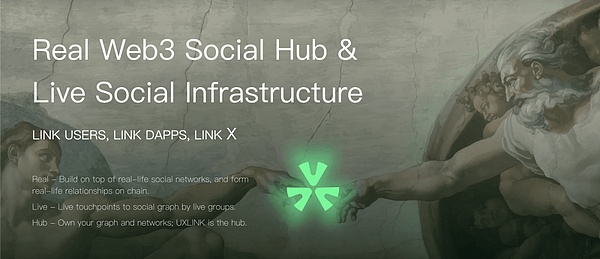
In the digital age, social networks have always been a key element. Currently, there are more than 4.8 billion users on Web2 platforms, while the number of users on Web3 platforms is less than 1%. Despite this, the migration of Web2 users to Web3 in the future is an inevitable trend. In order to support the large-scale adoption of Web3 and strengthen the connection to real-world social networking, UXLink proposes a method to combine real-world social networks with blockchain technology to provide open social relationship computing and recommendation services.
2. Detailed explanation of the mechanism
Specifically, UXLink has built a complex and efficient system architecture.
First, UXLink's user account and identity management system allows users to log in to the platform using existing social accounts (such as Telegram or WhatsApp) or blockchain wallets (such as MetaMask). This design allows users to seamlessly connect their real-world social relationships to the UXLink platform without having to register new accounts. The platform manages users' social identities and account information through the UXAccount service, and stores and manages users' social data, including friend relationships and group information, through the social account data service.
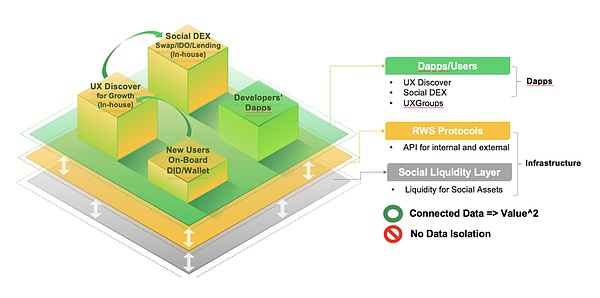
Secondly, UXLink builds and maintains users' social graphs through the UXGraph service, recording relationships and interactions between users. These graphs not only help users maintain their existing social networks, but also use social relationship computing functions to analyze interactions between users, provide recommendation services, and help users find new friends or groups, thereby enhancing their social experience.
In terms of the protocol service layer, UXLink has built an extensible technical architecture that can provide data and EVM+IPFS+Cloud on-chain and off-chain hybrids through APIs, providing rich API interfaces to help developers manage users' social identities and relationship data. Just like developing mini-programs in WeChat social relationships and developing Facebook Market Place in FACEBOOK, social relationships are used to generate high-quality growth and personalized user services, such as AI algorithms, recommendations, group building, etc., to form a complete ecosystem.
Finally, for the infrastructure layer, UXLink has created a hybrid extensible architecture (EVM +IPFS + Clouds), which is a lower-level infrastructure that allows social relationships and data to be assetized and flow. Through a multi-chain approach, users can circulate their social assets in various public chains and applications. It also uses MPC-TSS (Multi-party Computation Threshold Signature Scheme) technology to ensure the security and flexibility of wallet accounts, and supports group-based EOA (Externally Owned Account) account services to facilitate user group management and interaction.
3. Detailed Functionality
Through the above trusted social relationships and group models, UXLINK provides users with functions such as social mining, social DEX, and liquidity staking.

Social mining is a unique feature of UXLINK that rewards users for their active participation on the platform. By participating in various activities, such as posting, commenting, and interacting with other users, participants can earn Proof of Work (POW) points. These points can then be converted into token rewards. The system incentivizes users to actively participate and contribute to the community, cultivating a vibrant and engaged user base. Social mining essentially turns social interaction into a form of mining, where the "work" done is the user's participation and the "reward" is the cryptocurrency earned.
UXLINK's Social DEX is a decentralized exchange designed for social trading. It allows users to trade a variety of crypto assets directly with each other. Social DEX also integrates social features, allowing users to follow traders, view their activities, and make smarter trading decisions based on community insights.
Liquidity staking is another innovative feature of UXLINK. Users can stake crypto assets in the platform's staking liquidity pool (SLP) to earn proof-of-stake (POS) returns. By staking, users can contribute to the platform's liquidity, which is essential for the smooth operation of Social DEX and other trading activities. In return, stakers can receive rewards, including a portion of future listing rewards for tokens staked before the Token Generation Event (TGE) by UXLINK ecosystem partners. This mechanism not only incentivizes users to provide liquidity, but also provides potential returns for their staked assets, thus achieving a win-win situation.
AI Group Kits are AI-powered tools designed to help users manage and grow their networks more effectively. These tools can automate various aspects of group management, such as member engagement, content moderation, and activity analysis. By leveraging AI, UXLINK enables group leaders to focus on the strategic aspects of community building, while AI handles daily tasks. This not only enhances the user experience, but also ensures that groups remain active, organized, and relevant.
Group Kits are a set of tools designed to enhance social interaction and follower management. These toolkits include features such as group chat, event organization, and collaborative projects, all of which are enhanced by AI to provide a more interactive and engaging experience. Group leaders can use these tools to build closer connections within the community, organize events, and encourage collaboration among members. AI enhancements help tailor interactions based on user preferences and activity patterns, making the social experience more personalized and impactful.
4. Token Economics
In addition, UXLink's dual-token economic model is one of the important features of the platform. The platform uses two tokens, $UXUY and $UXLINK, to incentivize users and govern the platform.
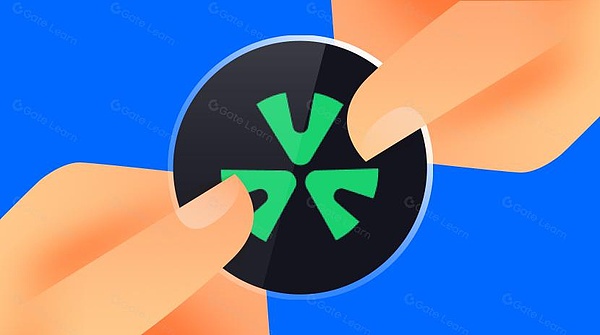
$UXUY is the core incentive token for the development of the UXLink community and ecosystem, and is mainly used to reward users' community contributions and social activities. Users can obtain $UXUY through the Link-to-Earn mechanism, participating in social interactions, completing tasks, etc. $UXUY is generated based on the on-chain PoW (Proof of Work) mechanism to ensure its fairness and incentive growth. $UXUY is non-transferable and can only be obtained through user contributions. Users can also use $UXUY to redeem services, rewards and specific rights within the platform.
And $UXLINK is mainly used for the governance and revenue distribution of the platform, and holders can participate in platform decision-making and governance voting. Users obtain $UXLINK by holding $UXUY and redeeming a specific number of $UXLINK, or by participating in specific activities and platform airdrops. $UXLINK is a token that can be traded on the market, and users can earn income by purchasing, trading and participating in platform governance. $UXLINK holders can participate in platform governance, vote on the development direction and major decisions of the platform, and obtain governance benefits from it.
Last month, exchanges such as OKX, Bybit, Gate, BitGet, KuCoin, HTX, HashKey Global, and BFX launched $UXLINK trading.
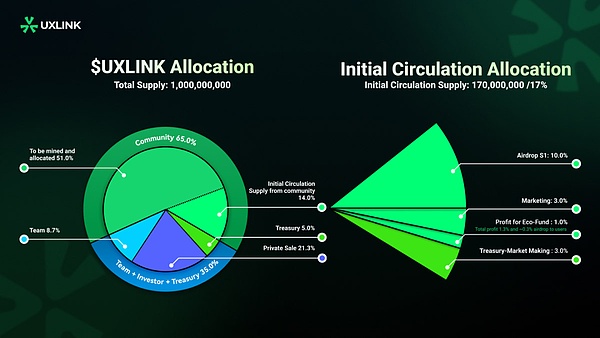
$UXLINK has a total supply of 1 billion (1,000,000,000).
The community gets the largest share, 65% of the total supply. This portion of tokens is used for a variety of purposes:
Airdrop S1: 10% of the tokens are allocated to airdrops and enter circulation immediately without a waiting period or lock-up period.
Marketing: 3% of the tokens are used for marketing, which also enters circulation immediately without a waiting period or lock-up period.
Profit for Eco-Fund: 1% of tokens are allocated to Eco-Fund profit, with no waiting period or lock-up period.
To be mined and allocated: 51% of tokens are used for future allocations and incentives, and these tokens will not enter circulation immediately.
21.3% of tokens are allocated to private placement investors. These tokens have a 6-month lock-up period and then unlock over 21 months.
The team receives 8.7% of tokens. These tokens have a 9-month lock-up period and then unlock over 21 months to ensure the team's long-term commitment and incentives.
5% of tokens are allocated to the project's inventory for liquidity and market making. Among them:
Liquidity (Market Making): 3% of the tokens are used for market making and enter circulation immediately without waiting period or lock-up period.
Project Development: 2% of the tokens are used for project development, with a 6-month lock-up period and then unlocked in 21 months.
UXLink also recently launched a comprehensive governance token $UXLINK airdrop plan.
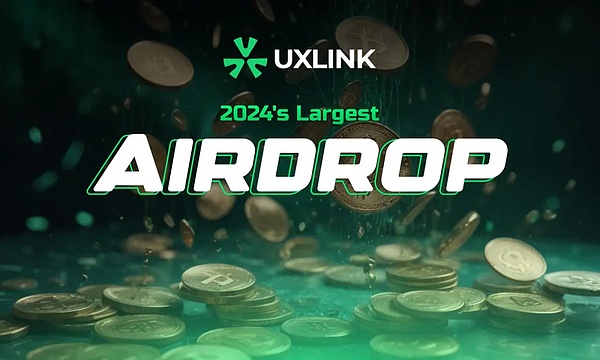
All eligible users will be evaluated based on their wallet address and UXLink account quality score. The main scoring indicators include user profile integrity, interactive activities with UXLink, social relationship chain activities, third-party trust assessment, Sybil identity verification, and third-party wallet certification. The quality score influencing factors include suspected Sybil accounts, uncertified wallet connections, low-value social networks, and participation in uncertified third-party activities.
Users who meet the following conditions will receive 100% airdrops:
Purchase NFTs on the official website with Ethereum (ETH).
Have a high UXLink social contribution score.
Pass anti-Sybil measurement by a professional third party.
Have a certified third-party wallet address.
Pass partner whitelist certification.
Please note that if users self-report within 3 days, they can receive 15% of the token airdrop compensation, and the remaining 85% of the tokens will be redistributed to qualified community contributors. If users do not self-report, they can submit appeal materials and proof within 6 months. After passing the review, they will receive 100% of the token airdrop; users who fail the review will not receive the airdrop, and their tokens will be transparently redistributed to qualified community contributors.
After summarizing and checking the airdrop data in the first quarter, the second quarter airdrop plan will be combined with community feedback to maintain transparency. All users must comply with the UXLink Terms and Conditions of Use. For users who are dishonest or misbehave, the community has the right to disqualify their tokens and redistribute them to the community.
In addition to the second quarter airdrop, in the second half of 2024, UXLink also plans to integrate WhatsApp so that users can interact more conveniently through familiar communication platforms. At the same time, continue to be listed on major CEX and DEX to further improve the liquidity and accessibility of the token. UXLink aims to achieve the data indicator of 10 million users by the end of the year.
In 2025, UXLink's focus will shift to developing more decentralized applications (dApps) to further enrich the platform's ecosystem. UXLink plans to achieve a milestone of 20 million users this year. In 2026, UXLink plans to achieve 30 million users and continue to further develop and connect projects.
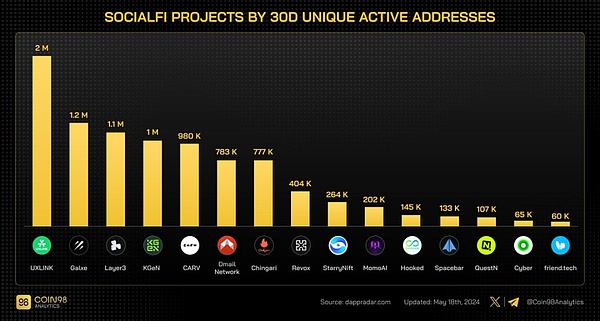
5. Project Evaluation
Currently, UXLink has achieved the target of 10 million registered users in 2024, with 15 million current users, more than 5 million on-chain points holders and more than 1.6 million NFT holders. The monthly active users on the chain exceed 1M, ranking first in DappRadar's on-chain active applications. As of June 30 this year, UXLINK's number of active independent addresses ranked first in the socialfi track, and had an absolute gap with the second place.
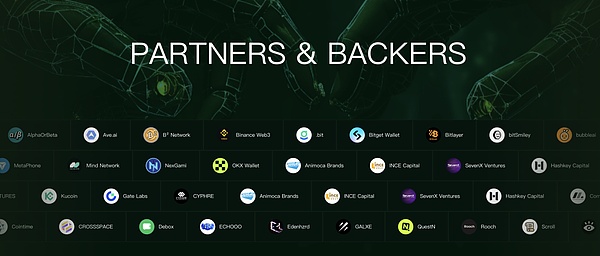
In addition to optimistic user data, UXLink's cooperation is also impressive. Not only did it receive a $5 million investment led by SevenX, HashKey Capital, and INCE Capital, with a total financing amount of over $15 million, its ecology has also developed further. UXLink's ecosystem covers multiple fields such as wallets, games, DeFi, payments, security audits, artificial intelligence, social networking, infrastructure, and Bitcoin ecosystems. According to the person in charge of the UXLINK ecosystem, more than 80 project parties that have joined the ecological cooperation are very satisfied with the business performance, and their communities and holders have achieved substantial growth. For example, Airdrop2049 was very successful.
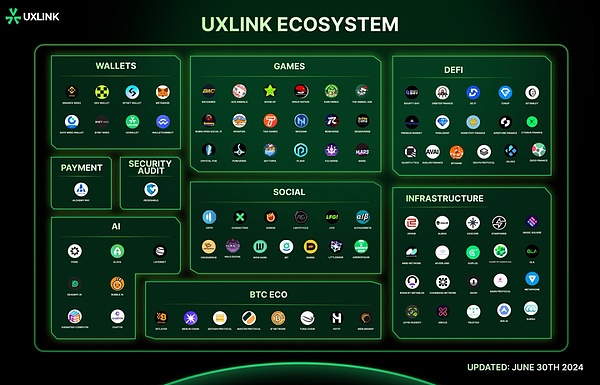
As for the team behind it, Sean is the founder and CEO of UXLink. Before founding UXLink, he was the founder and CEO of Xiangwushuo and worked as an investment banker at China International Capital Corporation Limited (CICC). He graduated from South China University of Technology and studied at Stanford University. Sean's career has focused on technology and entrepreneurship, and he has accumulated relevant blockchain experience and knowledge. Another co-founder, Bob Ng, is the CTO of UXLink and the co-founder of Happy Sharing. As an Internet veteran, Bob has rich expertise in mobile social and technology. He graduated from Wuhan University of Technology.
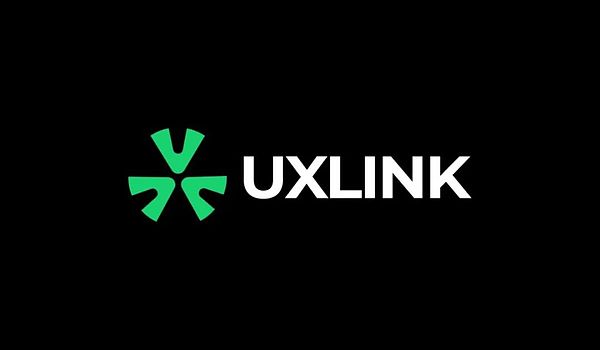
In short, in the customized Mass Adoption track, UXLink defines itself as a core node of an ecosystem based on the goal of breaking the limitations of a single market and forming a multi-dimensional and multi-level user and revenue structure.
From its development history, from quickly acquiring users based on Telegram's traffic pool, to achieving user growth through the Link-to-Earn mechanism, to the introduction of external developers and extensive ecological cooperation, UXLINK has shown considerable potential on the path of Mass Adoption.
It can be said that UXLink is a super linker, acting as a hub in the blockchain. Today, when Web3 does not take over each other and users do not trust project parties, the industry needs a linker between users and projects, a social media with a real user base to connect the entire market.
 Anais
Anais













